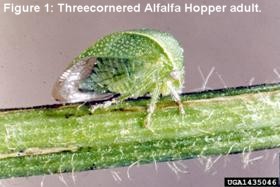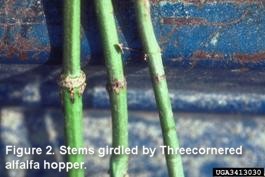Threecornered Alfalfa Hopper in Kentucky Soybeans
ENTFACT-153: Threecornered Alfalfa Hopper in Kentucky Soybeans | Download PDF
Spissistilus festinus (Homoptera: Membracidae)
by Doug Johnson, Extension Entomologist
University of Kentucky College of Agriculture
Description

Both immatures (nymphs) and adults have piercing-sucking mouthparts. Adults are usually green, sometimes brown, wedged-shaped insects (triangular as viewed from the top) that are about ¼ inch long. Nymphs are also wedge-shaped and have projections (spines) along the top of their body. Nymphs have five stages with the first appearing almost transparent, the second somewhat buff or brown and the final three green. Eggs are laid singly or in small clusters within the plant and, therefore, are protected from pesticides and very difficult to find.
Pest Status and Damage
Threecornered alfalfa hopper are common but not often of economic importance. They may be found on soybean from plant emergence to near maturity. Populations appear to be larger on later planted and reduced tillage soybeans. The importance of this insect is relative to the latitude at which they occur, with the importance generally increasing as one moves south. Both adult and juvenile stages may cause damage. On seedlings and young vegetative stage plants (less than 10-12 inches tall) insects feed using their piercing-sucking mouth parts to remove plant sap. Nymphs and adults can feed at random but often girdle plant stems and petioles by a series of punctures circling the stem or petiole. Girdling disrupts the movement of nutrients and water within the plant, which may result in plant death, reduction in seed weight or fewer seeds, or stem breakage. Feeding on branches and leaf petioles higher in the canopy in later plant stages, may result in small or aborted pods and reduction in seed weight. Early season lodging or plant death is often compensated by surrounding plants. However, lodging at R5 or later may result in significant loss.
Life History

The threecornered alfalfa hopper is native to the southern United States and Mexico. This insect can overwinter as an adult in protected areas or as eggs in protected plant tissue. Adults may remain active during the winter during warm periods. Adults and emerging nymphs from overwintered eggs feed on a wide variety of cultivated and uncultivated plants including the legume crops, cotton, clovers, dock, wild geranium, sunflowers, tomatoes, etc. moving into soybean in May and June. Development rate varies with temperature. Eggs take between 7-10 days at 88oF to develop. Nymphs take between 8-13 days to complete the five stages. Two generations usually appear in soybean with three adult peaks: overwintered adults entering the field, first generation adults within the field and second generation adults that will leave the soybeans for overwintering protection.
Management
Sampling methods usually include sweep net for adults and plant observation for damage and juveniles. Thresholds are not well established. Most recommendations are based on the experience of researchers working with this pest. Treatment for hoppers is recommended when 10% or more of the plants less than 10-12 inches tall are infested. Some researchers recommend treatment when 50% of the plants are girdled and hoppers are present. If plants are setting pods, a treatment threshold of 1 threecornered alfalfa hopper per sweep is sometimes recommended. In each field, multiple locations should be checked, usually five or more, and the numbers averaged over the locations. Insecticide for use on this and other soybean insect pests may be found in ENT-13, Insecticide Recommendations for Soybeans; available on line at: http://pest.ca.uky.edu/EXT/Recs/welcomerecs.html or at your local County Extension Office.
Reference
- Handbook of Soybean Insect Pests, L. G. Higley and D.J. Boethel (eds.) Entomological Society of America, 1994
- Steward, S., A. Thompson McClure, and R. Patrick. nd. Threecornered Alfalfa Hopper. UT Ext. W201.
Photograph Credits
- Figure 1. Threecornered alfalfa hopper adult. Clemson University – USDA Cooperative Extension Slide Series.
- Figure 2. Stems girdled by threecornered alfalfa hopper. David Adams, University of Georiga.
Issued: 10/13
CAUTION! Pesticide recommendations in this publication are registered for use in Kentucky, USA ONLY! The use of some products may not be legal in your state or country. Please check with your local county agent or regulatory official before using any pesticide mentioned in this publication.
Of course, ALWAYS READ AND FOLLOW LABEL DIRECTIONS FOR SAFE USE OF ANY PESTICIDE!
Images: University of Kentucky Entomology
